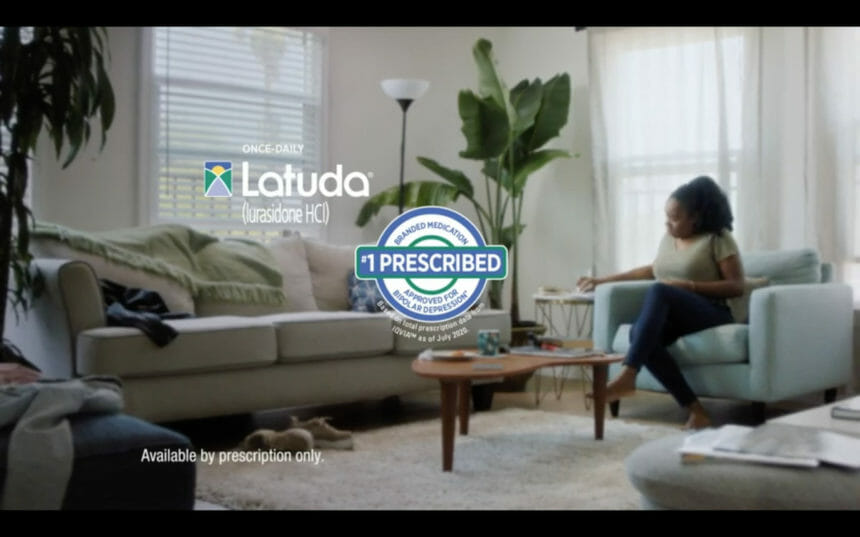On the surface, this week’s launch of “Real Expressions,” a new campaign for Sunovion’s bipolar depression drug Latuda, proceeded in much the same manner that most campaign launches do. Behind the scenes, however, creation and execution of the ad demanded a degree of logistical flexibility and problem-solving moxie more commonly associated with productions multiple times its size.
The reason for this, of course, was the coronavirus pandemic, which shut down production on ads – and most everything else – right around the time the “Real Expressions” shoot was set to shift into gear.
Unlike most other tales of COVID undermining well-laid plans, the story behind “Real Expressions” dates back to early 2019. That’s when the Latuda team and longtime Sunovion partner AbelsonTaylor started conducting the research that drove everything that followed.
“It was a lot of time in the making,” said Sunovion director of strategic brand marketing Michelle Gilson. “We took all the appropriate steps in terms of getting ready to produce the spot – and then came COVID.”
Production for “Real Expressions” was scheduled to begin in the first week of April. Casting was in its final throes, with AbelsonTaylor having already issued its callback recommendations for actors. “That’s how close we were,” noted AbelsonTaylor SVP, group creative director Jody Van Swearingen.
But in the second week of March, members of the Latuda/AbelsonTaylor team realized that existing schedules would have to be altered. As the virus spread over large swaths of the country, air travel restrictions kicked in. It became clear that all timetables going forward would be subject to the whims of a virus that hadn’t been identified 90 days prior.
“We started scenario-planning right away. Then we started scenario-planning for the various scenarios,” Gilson recalled. “It was stressful. ‘Okay, what if we can’t travel? How about if people can’t come out to be a part of this commercial?’”
While Van Swearingen said that Team Latuda took pains to keep all such discussions light – “we kept lovingly calling it our ‘puzzle within the puzzle’” – the behind-the-scenes push for information increased in urgency once the reality of stay-at-home orders sank in. Only two months later, in June, did Sunovion and AbelsonTaylor make the decision to move forward with the ad.
A host of conversations with production houses ensued. No options were off the table, as witnessed by one plan that ultimately became the runner-up: Filming the spot in Australia.
“It was the most open and it had the least restrictions on talent,” said AbelsonTaylor executive producer Melissa Taylor.
Other techniques considered included stop motion and animation. Ultimately, members of the campaign team pushed to maintain as much fidelity to the original idea as circumstances allowed.
The spot that debuted on Monday is true to that vision. To realize it, Sunovion and AbelsonTaylor partnered with production company Florence. They established 17 “quarantine pods,” each featuring a director of photography, actors (many nonprofessional) and crew members.
Filming proceeded over the course of 13 days (Taylor said most similar shoots take four or five days). While the team endured its share of headaches, most were minor in scope. “Some cell tower in Canada went down and we went dark for a bit while we were watching the footage live and giving feedback,” Gilson said.
At the same time, while she acknowledged the stress of having to develop solutions on the fly amid a global pandemic, Gilson added that at no point during the production process did she despair: “I knew there was a way for us to do this.” Recently, when she saw the final product, emotions finally got the better of her.
“I cried,” she recalled with a laugh.
Though the circumstances under which the spot was filmed were unique – within a few months, the country would significantly advance its knowledge of COVID-19, if not its efforts to wrestle it under control – Taylor said AbelsonTaylor gained valuable insight over the course of the process, protracted and non-linear as it proved to be.
“Production-wise, you need to add additional time for everything,” she stressed. “And it is all about the communications.”
Gilson agreed. “You’re going to have different casting. Wardrobe might not be what you want. Hair and makeup might not be available,” she said. “You need to forget about shoots of the past and embrace where you are today.”







